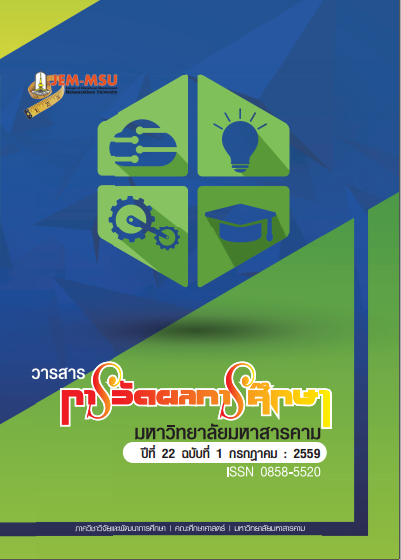Factors Influencing Pleasant Learning of Prathom Suksa 6 Students under Burirum Primary Educational Service Area Office
Main Article Content
Abstract
The purposes of this study were to; 1) investigate relationship between independent
variables and pleasant learning of Prathom Suksa 6 students under Burirum Primary Educational
Service Area Office 1; 2) develop and check validity of casual factors affecting pleasant
learning of Prathom Suksa 6 students under Burirum Primary Educational Service Area Office
1 and; 3) examine independent variables which indirectly and directly affected and direct
and indirect effects to pleasant learning of Prathom Suksa 6 students. The sample included
1,000 Prathom Suksa 6 students under Burirum Primary Educational Service Area Office 1 in
the first semester, academic year 2012. The sample was selected by using Multistage
Random Sampling. The research instruments were questionnaires about factors affecting
pleasant learning of Prathom Suksa 6 students with the discrimination of .207 to .854 and
with the reliability of .980. The factors affecting pleasant learning of students in terms of
classroom atmosphere, content appropriateness, teaching and learning activities, instructional
media, teaching evalution and teacher characteristics had the discrimination of .216 to .720,
.497 to .820, .283 to .876, .261 to .772, .461 to .746 , .574 to .784 respectively and had the
reliability of .858 , .910 , .897 , .853 , .870 , .916 respectively. The basic statisics and Path
Analysis were applied to analyze data.
The results could be summarized as follows.
1. The variables having positive relationship with pleasant learning of Prathom
Suksa 6 students was at the level of statistic significance of .01. These included classroom
atmosphere, teaching and learning activities, instructional materials, teaching evaluation and
teacher characteristics.
2. The validity of a casual relationship affecting pleasant learning of Prathom
Suksa 6 students under under Burirum Primary Educational Service Area Office 1 developed
from empirical data showed that the model was cosistent with the empirical data. The
statistics used to determine the validity of the model χ 2 = 10.842 , df = 1 , p-value =
0.0010 , CFI = 0.999, TLI = 0.980 , RMSEA = 0.099, SRMR = 0.001. All variables could
explain the variance of variables of pleasant learning at 53.80 percent. The effect size of
direct and indirect effect affecting pleasant learning of Prathom Suksa 6 students demonstrated
that the variables having direct and indirect effects to pleasant learning of the students were
classroom atmosphere, content appropriateness, teaching and learning activities and teacher
characteristics.
To conclude, the 6 factors were associated among each other. Therfore, involving
persons should be aware of these variables when planning, improving, promoting pleasant
learning.
Article Details
The content and information contained in the published article in the Journal of Educational Measurement Mahasarakham University represent the opinions and responsibilities of the authors directly. The editorial board of the journal is not necessarily in agreement with or responsible for any of the content.
The articles, data, content, images, etc. that have been published in the Journal of Educational Measurement Mahasarakham University are copyrighted by the journal. If any individual or organization wishes to reproduce or perform any actions involving the entirety or any part of the content, they must obtain written permission from the Journal of Educational Measurement Mahasarakham University.


